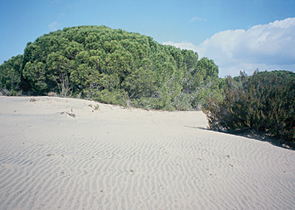Nature Conservation 3/2010 — 22. 6. 2010 — International Nature Conservation — Print article in pdf
The Doñana National Park

The Doñana National Park, also called Coto de Doñana, is located in Andalusia (Spain) and covers 543 km2. It protects the Guadalquivir River Delta region where the river flows into the Atlantic Ocean. There are five main ecosystem types within the park.
Approx. 30 kilometres of pristine beaches stretches from Matalascañas down to the delta. A breathtaking moving landscape of dunes has been formed by the Atlantic winds. Heathland or vera links the marshland and the stabilized sand of the forests. Umbrella Pines (Pinus pinea), Cork Oaks (Quercus suber), wild Olive (Olea europaea) and Juniper (Juniperus spp.) trees have covered the stabilized dunes. Marshlands attract annually half a million wintering birds, mainly wildfowl and waders while six million birds use them as a feeding station during the migration periods in spring and autumn. Serious threats to unique Doñana’s nature include contamination by agricultural runoff upstream from fertilisers and by pesticides used in large rice paddies and extensive strawberry fields, the use of river water to boost agricultural production by irrigating land along the coast, poaching and road traffic. In April 1998, a tailings dam at a mine at Aználcollar ruptured and caused the largest environmental pollution accident recorded in Europe’s history. As the dam broke, a large amount of black acidic, metal-rich sledge and water flowed down river to the estuary. The tailings spill not only had catastrophic short term effects, there are likely to be long-term effects on wildlife. The Iberian Lynx (Lynx pardinus) Breeding Programme has produced some cubs in captivity, but more than one third of the animals in the El Acebuche Breeding Centre and in the other Spanish facility have shown symptoms of Chronic Kidney Disease. In addition, deaths of the critically endangered cat due to bovine tuberculosis have been recorded in the wild Doñana’s population.

